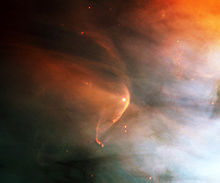Star wind

Stern wind is a continuous stream of matter that emanates from the surface of stars . Depending on the type of star, the wind speeds are between a few tens and several 1000 km / s, the observed mass loss rates range from to solar masses per year.
Star winds are an electrically conductive plasma and therefore interact with magnetic fields accordingly . They can carry the star's magnetic field far outwards and can keep interstellar matter and cosmic rays away from the star's vicinity. Bubble-shaped structures formed around the star are called astrospheres , in the case of massive stars also stellar wind bubbles ( English for "stellar wind bubbles"). The sun's astrosphere is the heliosphere and the sun's stellar wind is the solar wind .
Forms of stellar winds
There are different forms of star winds, which differ in their drive mechanism.
- Winds from cool stars like those from red giants are made up of neutral atoms and molecules like carbon monoxide, silicates and the like. These dusty winds are comparatively slow with only a few tens of km / s. The matter is accelerated in the atmosphere of the red giant by shock waves due to pulsations . At a certain distance from the star, at which the temperature has dropped sufficiently, the gas condenses into dust. The driving force is the radiation pressure on the molecules of the dust by scattering . The mass loss rates can be very high with up to solar masses per year. Such winds occur in the late phases of star evolution and are responsible, for example, for the formation of planetary nebulae .
- In sun-like main sequence stars , the wind consists of charged particles , mostly protons and electrons . Such winds as the solar wind are mainly driven by the extreme temperatures of the corona of a few million Kelvin . The gas pressure acting here accelerates the wind to a few hundred km / s. The sun is currently losing about solar masses per year, so its wind has no influence on the development of the sun. A corona forms in main sequence stars with an outer convection layer. This thin atmosphere is heated to several million Kelvin (by processes that are not yet fully understood), and as a result the components of the plasma achieve a heat movement that is sufficient to flow away as a stellar wind.
- Winds from hot stars , from a surface temperature of around 10,000 K, have the same chemical composition as the star's surface itself. Most of the atoms here are single or multiple ionized . These winds can reach speeds of a few thousand km / s. Winds of hot stars are also driven by the radiation pressure of the central star, but unlike cool winds, it does not work by scattering the continuous star spectrum, but by absorption in spectral lines in the ultraviolet range. The mass loss rates ranging from in main sequence stars than in supergiants to in Wolf-Rayet stars . The extreme star η Carinae lost about half a solar mass per year during an eruption that lasted about twenty years around 1840. The stellar wind from hot stars is highly inhomogeneous . The inhomogeneity can be observed indirectly in wind accreting X-ray binary stars . The stellar wind is captured by a compact star , a white dwarf , a neutron star or a black hole , and transferred to the star via an accretion disk . When it hits the surface of a white dwarf or neutron star, X-rays are released as thermal radiation that is directly proportional to the amount of accreted wind. This makes it possible to analyze the lumpy structure of the stellar wind of hot stars.
- In some types of stars, the material accrete , such as T Tauri stars , a wind of a can in the form of jets form. Part of the material falling onto the star is deflected by a magnetic field and thrown away along the polar axis.
- The stellar winds of interacting binary star systems can collide at high speed and generate radio, X-ray and gamma radiation in the process. Such systems are called colliding wind binary .
Influence on the evolution of the star
While stellar winds in the main sequence stage do not have much influence on the evolution of the star, the later stages are decisively influenced by it. Many massive stars only develop into white dwarfs and do not explode as a supernova because they have lost sufficient mass beforehand.
Web links
Individual evidence
- ↑ HJ habing, H. Olofsson: asymptotic giant branch stars (Astronomy and Astrophysics Library) . Springer, Berlin 2003, ISBN 0-387-00880-2 .
- ↑ H. Scheffler, H. Elsässer: Physics of the sun and the stars . Bibliographisches Institut, Mannheim 1990, ISBN 3-411-14172-7 .
- ↑ R. Kippenhahn, A.Weigert: Stellar Structure and Evolution (Astronomy and Astrophysics Library) . Springer Verlag GmbH, Mannheim 1994, ISBN 978-3-540-50211-1 .
- Jump up ↑ Anabella T. Araudo, Valenti Bosch-Ramon, Gustavo E. Romero: Transient gamma-ray emission from Cygnus X-3 . In: Astrophysics. Solar and Stellar Astrophysics . 2011, arxiv : 1104.1730 .
- ↑ L. Hartmann: Accretion Processes in Star Formation (Cambridge Astrophysics) . Cambridge University Press, Cambridge 2001, ISBN 978-0-521-78520-4 .



